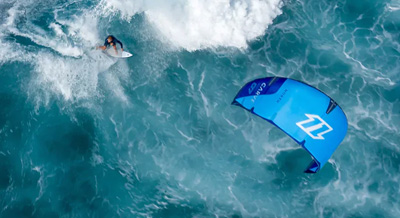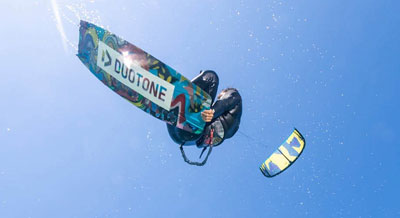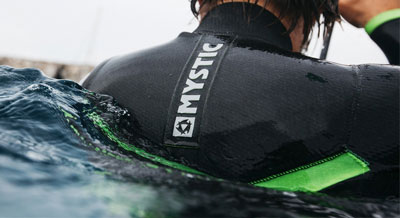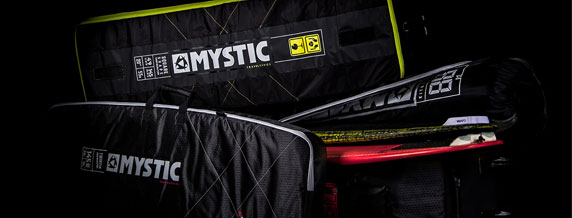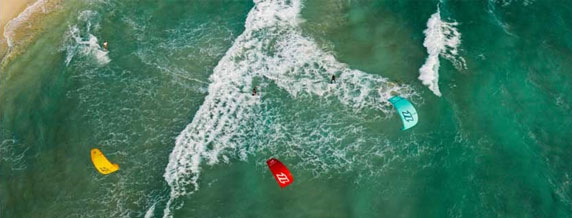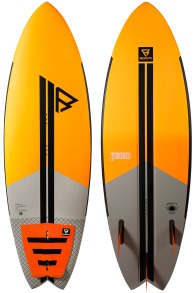Kiteboard - Surfboard
More and more kiters are finding it exciting to add a surfboard (also called a directional) to their collection. Some kiters even fully transition to wave riding because it offers them a new challenge and an amazing thrill. With wave riding, you can catch any wave you want! The kite surfboards used in this discipline are based on designs from the surfing world. There are many different shapes available. However, these surf kiteboards need to be much sturdier because they endure a lot of pressure during kiting. Additionally, riding upwind is an important aspect. Kitemana offers an extensive range of wave riding kiteboards. Do you have a question about these directional surfboards, or would you like to test one? Feel free to contact us. Read more »
More and more kiters are finding it exciting to add a surfboard (also called a directional) to their collection. Some kiters even fully transition to wave riding because it offers them a new challenge and an amazing thrill. With wave riding, you can catch any wave you want! The kite surfboards used in this discipline are based on designs from the surfing world. There are many different shapes available. However, these surf kiteboards need to be much sturdier because they endure a lot of pressure during kiting. Additionally, riding upwind is an important aspect. Kitemana offers an extensive range of wave riding kiteboards. Do you have a question about these directional surfboards, or would you like to test one? Feel free to contact us. Read more »
Surfboards at Kitemana
Buying surfboards at Kitemana is very easy. We have a wide selection of surfboards from all top brands in stock. At Kitemana, we have surfboards in stock for beginners and advanced wave kiters, each with their own unique characteristics. Whether you are just starting to ride a directional or want to take your skills to the next level, we have the perfect wave board for you. Our diverse assortment ensures that you will find the ideal surfboard that suits your surfing style and preferences. At Kitemana, we understand that the right surfboard can make a big difference in your surfing experience. That is why we only offer the best brands, so you are guaranteed quality and performance. Our customer service team is always ready to provide you with advice and help you choose the best surfboard! On this page, you will find a number of frequently asked questions to make your search for the perfect surfboard a little easier. We are always here to answer any questions you may have and assist you in making the right choice.
Frequently Asked Questions When Purchasing a Surfboard:
- 1. What is a surfboard?
- 2. What types of surfboards are there?
- 3. Which surfboard is best for beginners?
- 4. What size should my surfboard be?
- 5. How do the outline, rocker, and rails change the riding characteristics of a surfboard?
- 6. How do the nose and tail change the riding characteristics of a surfboard?
- 7. Should I use straps on my surfboard?
- 8. Which fin setup should I choose for my kite surfboard - thruster or quad fins?
- 9. What fin size should I choose for my directional kiteboard?
- 10. What are the advantages and disadvantages of wax and surf pads for kite surfboards?
- 11. What is a Foil-Convertible Kiteboard?
- 12. Which surfboard brands does Kitemana sell?
1. What is a surfboard?
A surfboard for kitesurfing, often called a "directional," is a type of kitesurfboard designed to ride in one direction, similar to a traditional surfboard. Unlike twintips, which are symmetrical and can be ridden in both directions. Directionals have a front (nose) and a back (tail), meaning you need to change your foot position to change direction, a maneuver known as "gybing."
Directional kiteboards are ideal for kitesurfers who want to focus on wave riding because they have the shape and characteristics of surfboards. They are often longer and have more volume than twintips, making them float better and glide more easily over waves. These boards are equipped with fins on the bottom that provide extra grip and stability, which is essential for carving waves and making sharp turns.
What types of surfboards are there?
There are different types of surfboards for kitesurfing, each designed with specific characteristics to meet various riding styles and conditions. Here are some of the most common types:
Pure wave surfboards
Pure wave surfboards are specifically designed for waves. These surfboards are optimized for wave riding and offer excellent performance in medium to large waves. Pure wave surfboards have a narrow nose and a round or pin tail, providing maximum grip and control while riding the wave. The deeper rocker of these boards allows for sharp turns and easy rail engagement in the wave.
Freestyle surfboards
Freestyle surfboards are designed for kitesurfers who want to focus on tricks and big air. These boards are shorter and lighter, making them perfect for strapless tricks and aerial maneuvers. Freestyle surfboards often have a flat rocker and sharp rails for better pop and control during jumps. They are built to be robust yet lightweight, so they can withstand the impact of landings during tricks.
Allround surfboards
Allround surfboards are versatile surfboards designed to perform well in various conditions. These boards are often a combination of a pure wave and freestyle surfboard, making them great in many different situations.
Foil Convertible Surfboards
Foil convertible surfboards are versatile surfboards that can also be used in combination with a foil. These surfboards have a reinforced construction and are often equipped with a foil mount, making them suitable for both wave riding and hydrofoiling. These boards offer the possibility to kitesurf with a foil in light wind or to surf waves with traditional fins. Foil convertible surfboards combine the benefits of surfing and foiling, making them ideal for kitesurfers who want to travel with less gear or simply want a single board for everything.
bekijk hier onze verschillende kiteboards
twintips surfboards lightwind kiteboards tweedehands kiteboards foil kiteboards
Which surfboard is best for beginners?
To start wave kiting, it is good to choose a reasonably stable waveboard. A directional kiteboard gets its stability mainly from its width. Wave kiteboards gain width and therefore stability through features such as a blunt nose and a square tail. The width gives the directional kiteboard slightly less speed but much more stability. These characteristics make it easier to maintain your balance and practice maneuvers more effectively.
What size should my surfboard be?
The right size for your directional kiteboard depends on several factors, such as your body weight and the conditions in which you primarily kite. A heavier person should always choose a larger board than a lighter person. If you often kite in strong winds, your directional kiteboard can be smaller. If you prefer kiting in small waves, your directional should be highly maneuverable and therefore smaller. For large waves, on the other hand, you need a larger directional board to catch the speed of the wave and gain more down-the-line speed.
How do the outline, rocker, and rails change the riding characteristics of a surfboard?
Outline
The outline of a directional can be more or less straight or round. The rounder the outline, the more agile and easier the waveboard is to turn. However, a rounder outline limits the speed of the kiteboard. The straighter the outline, the more stable the directional kiteboard is and the more speed it can build. These boards, however, maneuver more slowly and turn in a larger radius.
Rocker
Just like with twintips, the rocker of directional kiteboards affects how much contact the surfboard has with the water surface. A flat rocker makes the waveboard fast, while a high rocker makes the kiteboard agile and makes dynamic turns easier.
Rails
The rails of directional kiteboards can be so-called "sharp rails" or "soft rails." The sharper the rails, the more grip and hold a surfboard has when carving, in turns, and at high speeds. These characteristics are especially important as the waves get bigger. Directional boards with sharp rails require some experience with wave riding. If the rails are soft, the board has more buoyancy and is more forgiving, but you can't edge as precisely. A directional with soft rails is particularly suitable for small waves and for beginner wave kiters.
How do the nose and tail change the riding characteristics of a surfboard?
Nose
Wave kiteboards can have different shapes, such as boards with and without a nose (noseless) and many different tail shapes. A noseless directional offers more stability and buoyancy. This makes the board very suitable for light wind sessions, starting with directional riding, and kiting in shallow water or small waves. Examples of noseless surfboards include the F-One Magnet and the Cabrinha Method.
A pointed nose makes a directional board more performance-oriented. The surfboard can reach higher speeds and is much more maneuverable. Such a wave kiteboard is perfect for larger waves and fast turns but is less stable. Examples of surfboards with a pointed nose include the North Charge and the Brunotti Boomer.
Tail
For the tail of a directional kiteboard, the rule is: the wider the tail, the more guidance, buoyancy the surfboard has, and the faster the surfboard planes. This tail shape is very suitable for smaller waves, starting with wave riding, and light wind sessions. This tail shape is often a bit slower. The narrower and sharper the tail shape, the more maneuverable and faster the wave kiteboard is. A narrow tail gives the kiteboard more grip in large waves. On the other hand, it has less buoyancy and requires more power from your kite between waves. Here are some examples of different tails:
Round tail
A kite wave surfboard with a round tail performs best at high speeds and on high, hollow waves. It ensures that the water flows smoothly around the contour of the surfboard. This results in round, fluid turns with more speed. A surfboard with a good example of this round tail is the Core Green Room.
Square tail
The square tail is one of the first surfboard tail designs. A wide tail provides stable water flow. However, this square tail results in less curve in the turns. You can still make very radical turns because it digs hard into the water when making a turn. A surfboard with a good example of this square tail is the Duotone Voke.
Squash tail
Another common tail in kiting is the squash tail, which is a variation of the square tail. The edgy shape of the tail ensures a quick release of the water. This makes the board very responsive and sharp in snappy turns. The shape is slightly wider at the back, providing more lift and earlier planing. The rounded ends give the board more grip than the square outline. A versatile design with a lot of control in both large and small waves. A surfboard with a good example of this squash tail is the Naish Skater.
Swallow tail (fish)
A tail design with two pin tails at the end is the fish, or swallow tail. This gives the board more hold and helps it get up to speed faster. It also provides more control and bite when making turns. The fish retains its speed better on smaller waves. The wider this fish tail is, the harder it becomes to turn from one side to the other. Rail to rail turns become more difficult with a wide fish. A surfboard with a good example of this swallow tail is the Reedin Super Wave.
Should I use straps on my surfboard?
Whether you ride with or without straps on your directional, it's mostly a matter of preference. Straps can be advantageous when you start wave riding because they provide more grip and a better board feel. Even in very large waves, advanced riders often use straps to have extra board feel and to be able to ride at high speeds more easily. Also, you can carve harder with a waveboard with straps than without.
For many kiters, the feeling of freedom that riding without straps provides is the reason why they love directionals so much. There are boards that can be ridden with or without straps. Surfboards with inserts can be ridden with straps, and surfboards without inserts can only be ridden strapless. So, if you're not sure whether you want to ride with or without straps, choose a board with inserts for straps.
Which fin setup should I choose for my kite surfboard - thruster or quad fins?
Thruster fin setup
A thruster fin setup, with three fins, offers several benefits that make it a popular choice among kite surfers - after all, it's one of the most used setups in the surfing world. This setup provides excellent stability and control, especially at higher speeds and in challenging conditions. This makes it easier to make sharp turns and maintain course, which is essential for riding in the waves. Additionally, the thruster setup is versatile and suitable for various types of conditions and riding styles. Whether you're surfing in small or medium-sized waves, with a thruster setup, you'll have a reliable setup guaranteed.
Quad fin setup
A quad fin setup, with four fins, offers unique benefits that make it an excellent choice for more specific kite surfing styles and conditions. This setup provides less resistance in the water, resulting in higher speeds and a looser feel while surfing. This makes quad fins particularly suitable for strapless freestyle and surfing in high, steep waves. With a quad setup, you can easily make sharp turns and quick transfers, making your surfboard and your session much more playful.
For further explanation about the different fin setups and the difference between, for example, FCS and Futures fins, you can visit this page.
What fin size should I choose for my directional kiteboard?
The fin size of your directional depends on your weight. The rule is that the heavier you are, the bigger the fins you need. On the other hand, the choice of fin size essentially depends on what you want to do with your directional kiteboard. For sharp turns, precise carving, and more relaxed upwind riding, you need more grip, so larger fins are better suited. For strapless freestyle or riding with a directional in shallow or choppy water, a more playful board with smaller fins is an advantage.
What are the advantages and disadvantages of wax and surf pads for kite surfboards?
Wax
Surfpads for surfboards have both advantages and disadvantages. Whether you prefer wax or a surf pad is often a matter of personal preference. A big advantage of wax is that it doesn't change the design of your directional board and gives you that "real surf feeling". Additionally, wax can sometimes provide a bit more grip compared to pads. However, a disadvantage of wax is that sand sticks to it, so you have to reapply it regularly. Also, you should be careful not to get wax inside your car during your drive to the beach.
Surfpads
Surfpads, on the other hand, are less complicated to use and offer similar performance for most kitesurfers. They require less maintenance than wax, and you don't have to worry about leaving a mess behind. The downside is that pads can alter the appearance of your board, and some surfers find that they provide less grip than wax. Ultimately, the choice between wax and surfpads depends on your personal preference and your willingness to wax your surfboard regularly.
What is a Foil-Convertible Kiteboard?
A foil convertible kiteboard is a surfboard that you can use as both a directional kiteboard and a kitefoilboard. This type of surfboard has special inserts that allow you to attach a foil mast. This enables you to easily switch between ripping waves and foiling in light wind, depending on the conditions and your personal preference. Foil convertible kiteboards offer the flexibility to switch between both disciplines without needing two separate surfboards, which is convenient for kitesurfers who prefer to travel light.
Advantages and Disadvantages of Foil-Convertible Kiteboards
The advantage of a foil-convertible kiteboard is that you have to carry less equipment with you if you want to be equipped for both strong winds and light winds. When traveling by plane, you have to check in less luggage, or you have more space for other things in your camper van. However, if you are a performance-oriented wave kiter and/or foiler, you will realize that a board that combines both in one cannot offer you the same performance as a dedicated foilboard or directional.
Which surfboard brands does Kitemana sell?
In the Kitemana online shop you will find Surfboards for kitesurfing from the following brands:
Airush: BY INNOVATORS FOR INNOVATORS
Appletree: LIGHTEST, STRONGEST AND BEST-PERFORMING KITESURF BOARDS
Brunotti: RIDER DEVELOPED PRODUCTS
Cabrinha: LIVE FREE. RIDE FREE.
Core Kiteboarding: PREMIUM KITES & BOARDS FROM FEHMARN, GERMANY.
Duotone Kiteboarding: TRUE KITEBOARDING.
F-One: ENJOY ALL CONDITIONS, TRY OUT NEW THINGS, OPEN UP YOUR PLAYGROUND
Firewire: THE FUTURE UNDER YOUR FEET
Naish: POWERED BY NATURE.
North: FOR THE SEEKERS.
Reedin Kiteboarding: IMAGINE KITEBOARDING #BEYOND
Slingshot: THE ART OF POWER
Added to basket
| Subtotal | $ 0,00 |
| Shipping costs US | $ 54,95 |
| Total Total(excl VAT) | $ 54,95 |
You have no product(s) in you basket.

